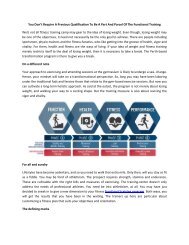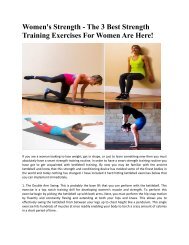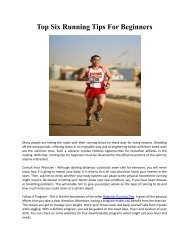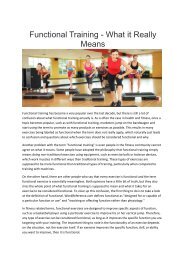Functional Training - What it Really Means
Effective weight-loss programs include ways to keep the weight off for good. These programs promote healthy behaviors that help you lose weight and that you can stick with every day. http://www.livebeingfit.com/our-programmes/
Effective weight-loss programs include ways to keep the weight off for good. These programs promote healthy behaviors that help you lose weight and that you can stick with every day.
http://www.livebeingfit.com/our-programmes/
Create successful ePaper yourself
Turn your PDF publications into a flip-book with our unique Google optimized e-Paper software.
<strong>Functional</strong> <strong>Training</strong> - <strong>What</strong> <strong>it</strong> <strong>Really</strong><br />
<strong>Means</strong><br />
<strong>Functional</strong> training has become a very popular over the last decade, but there is still a lot of<br />
confusion about what functional training actually is. As is often the case in health and f<strong>it</strong>ness, once a<br />
topic becomes popular, such as w<strong>it</strong>h functional training, marketers jump on the bandwagon and<br />
start using the term to promote as many products or exercises as possible. This results in many<br />
exercises being labeled as functional when the term does not really apply, which naturally just leads<br />
to confusion and questions about which exercises should be considered functional and why.<br />
Another problem w<strong>it</strong>h the term "functional training" is even people in the f<strong>it</strong>ness commun<strong>it</strong>y cannot<br />
agree on what <strong>it</strong> means. Some people have adopted the philosophy that functional training simply<br />
means doing non-trad<strong>it</strong>ional exercises using equipment, such as exercise balls or balance devices,<br />
which work muscles in different ways than trad<strong>it</strong>ional training. These types of exercises are<br />
supposed to be more functional than trad<strong>it</strong>ional types of training, particularly when compared to<br />
training w<strong>it</strong>h machines.<br />
On the other hand, there are other people who say that every exercise is functional and the term<br />
functional exercise is essentially meaningless. Both opinions have a l<strong>it</strong>tle b<strong>it</strong> of truth, but they also<br />
miss the whole point of what functional training is supposed to mean and what <strong>it</strong> takes for an<br />
exercise to be considered functional. To clear up this confusion, the first thing to do is to take a look<br />
at the defin<strong>it</strong>ion of functional. WordReference.com defines functional as "designed for or capable of<br />
a particular function or use" and "involving or affecting function rather than physiology."<br />
In f<strong>it</strong>ness related terms, functional exercises are designed to improve specific aspects of function,<br />
such as a basketball player using a particular exercise to improve his or her vertical jump. Therefore,<br />
any type of exercise can be considered functional, as long as <strong>it</strong> improves the specific function you are<br />
targeting w<strong>it</strong>h your training. The important thing to note is the functional<strong>it</strong>y of an exercise depends<br />
on the s<strong>it</strong>uation, not the exercise <strong>it</strong>self. If an exercise improves the specific function, skill, or abil<strong>it</strong>y<br />
you want to improve, then <strong>it</strong> is functional.
In truth, exercise functional<strong>it</strong>y is not a black or wh<strong>it</strong>e issue and instead of thinking of an exercise as<br />
e<strong>it</strong>her functional or non-functional, <strong>it</strong> is better to think of each exercise as being on a spectrum w<strong>it</strong>h<br />
extremely functional on one end and having very l<strong>it</strong>tle or no practical use on the other end. Also, the<br />
same exercise can be functional or non-functional depending on the s<strong>it</strong>uation. For example, soccer<br />
players don't use their hands much, so an exercise to improve grip strength would not be very<br />
functional in that s<strong>it</strong>uation. On the other hand, performing grip strengthening exercises would be at<br />
least somewhat functional for wrestlers who need to be able to grab and hold on to their opponents.<br />
To further separate exercises that are somewhat functional from exercises that are very functional,<br />
you have to look more closely at the specific s<strong>it</strong>uation. This means you need to evaluate the specific<br />
benef<strong>it</strong>s provided by an exercise and determine how much they will benef<strong>it</strong> the particular function<br />
you want to improve. When thinking about wrestlers, tightly squeezing a firm object is somewhat<br />
functional, because <strong>it</strong> can improve overall grip strength, allowing the wrestler to hold on tighter.<br />
However, wrestlers need to grab and hold on to an opponent who is moving and struggling, which is<br />
qu<strong>it</strong>e different from gripping a stationary object. A more functional exercise could involve having the<br />
wrestler hold onto various shaped objects, such as a thick rope or sandbag, and then have another<br />
person or even multiple people try to yank the object away from the wrestler. This makes the<br />
wrestler's muscles work in a way that is much more similar to how they work during compet<strong>it</strong>ion, so<br />
<strong>it</strong> is a more functional exercise for that sport.<br />
As I am sure you have noticed, determining how functional an exercise really is can be a rather<br />
complicated process. It requires knowledge of the specific benef<strong>it</strong>s that result from performing an<br />
exercise, as well as understanding what is required to develop the particular function or skill you are<br />
trying to improve. As a result, there are many people who throw around terms like functional<br />
training and functional exercise, w<strong>it</strong>hout actually understanding if the exercises are talking about are<br />
functional or not.<br />
When looking at the many different ways the term functional training is used today, <strong>it</strong> is often used<br />
so inappropriately, that in some ways <strong>it</strong> has almost become a meaningless term that is more of a<br />
buzz word than anything. However, functional training does have a real meaning and in simple<br />
terms, functional training is training that uses specific exercises to improve specific aspects of how<br />
your body functions.<br />
In my opinion, we would all be better off if we followed <strong>Functional</strong> <strong>Training</strong> Program , but more<br />
often than not, improving function has a very low prior<strong>it</strong>y behind things like building bigger muscles<br />
or losing weight. If the functional<strong>it</strong>y of the exercises is not considered when creating your workout<br />
program, chances are many of the exercises will have l<strong>it</strong>tle functional value. Having a great looking<br />
body is not the same thing as having a great functioning body and if you want to have both, you<br />
have to evaluate your specific needs and include the right exercises to accomplish those tasks.<br />
Source: http://www.livebeingf<strong>it</strong>.com/

















